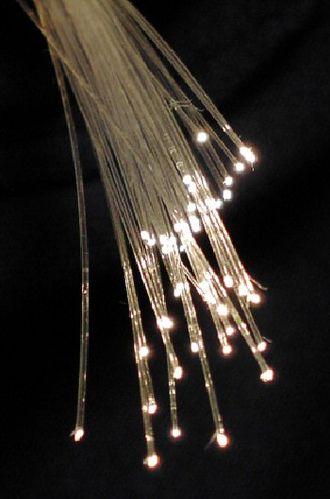Doping glass to function like a transistor could lead to super-fast computers
November 11, 2014

Optical fibers (credit: Wikimedia Commons)
British researchers have developed a new glass material that could allow computers to transfer information via light, significantly increasing computer processing speeds and power in the future.
The research by the University of Surrey, in collaboration with the University of Cambridge and the University of Southampton, has found it is possible to change the electronic properties of amorphous chalcogenides.
This is a glass material used in CDs and DVDs that can change state between glassy and crystalline when it’s struck by a laser beam to store binary data or have its state read to retrieve data.
Glass optical fibers are used to send information on the Internet at the speed of light, but once they reach a computer, these signals then have to be converted to slower electrical signals, causing a significant slowdown in processing. So finding a way to combine light and electrons into one medium has long been sought.
Now, the researchers have doped (by ion implantation) chalcogenide glass films with bismuth (a metal), so the chalcogenide glass (normally a p-type semiconductor) is able to function like a semiconductor with a p-n junction (as in a transistor). This could lead to all-optical computers, that “could transform the computers of tomorrow, allowing them to effectively process information at much faster speeds,” said project leader Richard Curry of the University of Surrey.
The researchers expect that the results of this research will be integrated into computers within ten years. The research was published in the journal Nature Communications.
Abstract of n-type chalcogenides by ion implantation
Carrier-type reversal to enable the formation of semiconductor p-n junctions is a prerequisite for many electronic applications. Chalcogenide glasses are p-type semiconductors and their applications have been limited by the extraordinary difficulty in obtaining n-type conductivity. The ability to form chalcogenide glass p-n junctions could improve the performance of phase-change memory and thermoelectric devices and allow the direct electronic control of nonlinear optical devices. Previously, carrier-type reversal has been restricted to the GeCh (Ch=S, Se, Te) family of glasses, with very high Bi or Pb ‘doping’ concentrations (~5–11 at.%), incorporated during high-temperature glass melting. Here we report the first n-type doping of chalcogenide glasses by ion implantation of Bi into GeTe and GaLaSO amorphous films, demonstrating rectification and photocurrent in a Bi-implanted GaLaSO device. The electrical doping effect of Bi is observed at a 100 times lower concentration than for Bi melt-doped GeCh glasses.